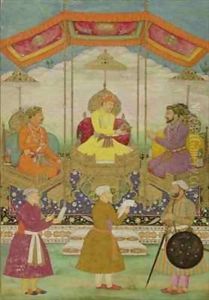Bichtir Paintings
Bichitr, also spelled Bichitr or Bishndas, was a notable Indian painter of the Mughal era, born in 1545 and passing away in 1616. His artistic career flourished primarily during the reign of Emperor Jahangir, who ruled from 1605 to 1627, and he continued to be active in the court of Jahangir's successor, Shah Jahan. Bichitr is renowned for his mastery in portraiture and for incorporating rich details and vibrant colors into his works, which was a hallmark of Mughal painting.
Bichitr's legacy includes a variety of works, ranging from individual portraits of the Mughal emperors and their courtiers to illustrations of historical and mythological narratives. One of his most famous works is the 'Jahangir Preferring a Sufi Shaikh to Kings', a painting that epitomizes the ethos of Jahangir’s reign, highlighting the emperor's preference for spiritual over worldly authority. This painting is notable for its symbolic representation, intricate detail, and the use of allegory, and it features a portrait of Jahangir himself, which showcases Bichitr's skill in capturing likeness.
Despite the prominence of his work, not much is known about Bichitr's personal life, and he remains a somewhat enigmatic figure beyond his contributions to the art world. His paintings, however, provide a valuable insight into the cultural and social milieu of the Mughal court. Bichitr's influence persisted beyond his lifetime, contributing significantly to the development and evolution of Mughal painting. His works are preserved in several major museums around the world, serving as a testament to his skill and the enduring appeal of Mughal art.
Through his dedication to his craft, Bichitr played a crucial role in defining the aesthetic principles of Mughal painting, blending Persian influences with Indian themes and techniques. His legacy is not just in the beauty and intricacy of his paintings but also in his contribution to the cultural heritage of India, making him an enduring figure in the history of South Asian art.
